William Henry Walmsley, 1830 - 1905
by Brian Stevenson
last updated January, 2018
W.H. Walmsley was a well-regarded microscope slide-maker, beginning in the mid-1860s and extending into the 1880s. He was fortunate to turn his expertise in microscopy, and his experience as a retailer of finely-crafted machinery, into ownership of some of the largest distributors of microscopical, optical, scientific and photographic equipment in the U.S.A. He was sequentially co-owner of J.W. Queen & Co., U.S. distributor for R. & J. Beck, then owner of several self-named corporations. Walmsley was a founder of the American Society of Microscopists, a Fellow of the Royal Microscopical Society, and member of several other scientific organizations.
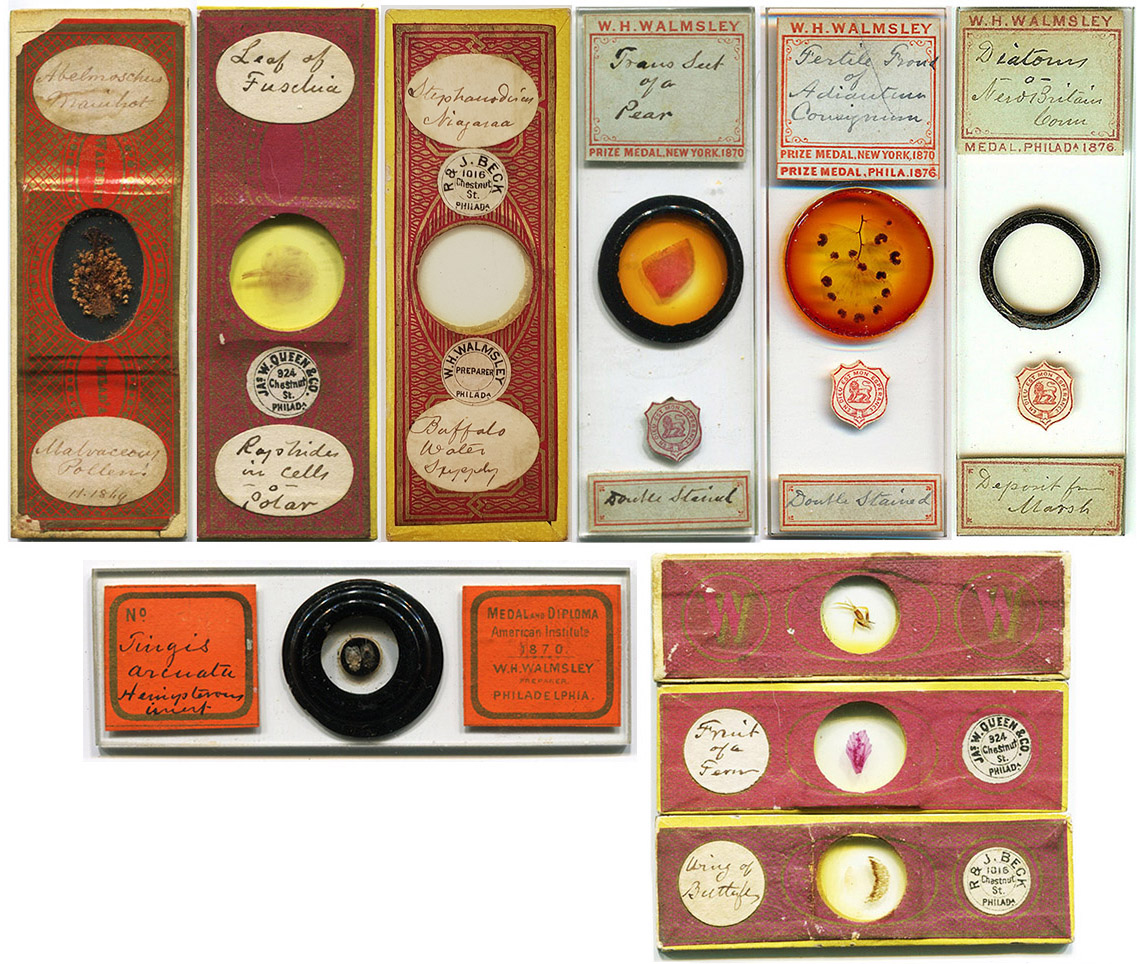
Figure 1.
Microscope slides by William H. Walmsley. It appears that all of these slides were prepared by Walmsley himself. The example at upper right has cover papers with “Walmsley” and “Philad’a” included on either side of the specimen, and is dated November, 1869. The slide next to it has similar handwriting, a similarly patterned cover paper, without the name or address, and has a circular sticker from Jas. W. Queen & Co. - this slide was probably made by Walmsley after he joined Queen (1870) and was prepared for sale by that business. The third slide from the right dates from Walmsley's time with R. & J. Beck, 1879-1884. The other, un-papered slides on the top row can be dated by the prizes noted on the labels, after 1870 if stating the New York prize, and after 1876 if stating the prize from Philadelphia. The orange-labeled slide announces the 1870 prize, but not the 1876 award. The three slides next to this are small, “continental” sized, carry Walmsley’s “W” monogram printed in the cover papers, and date from 1870-1877 (with J.W. Queen & Co. label) or 1879-1884 (with R. & J. Beck, 1016 Chestnut St. label). Other continental-sized slides are known that bear R. & J. Beck’s 1877-1879 address of 921 Chestnut Street. An enlarged view of the Walmsley-papered slide is shown at the end of this essay, in Figure 20.
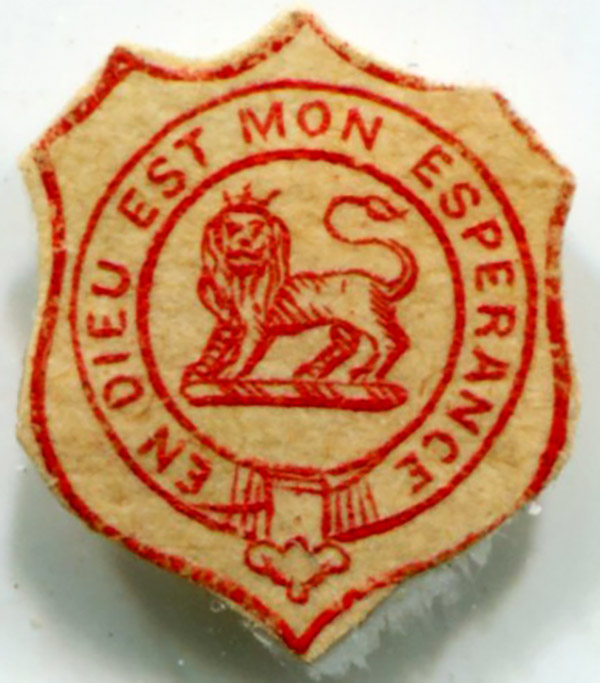
Figure 2.
The emblem found on many of Walmsley’s microscope slides. The motto, “en dieu est mon esperance”, translates as “in God is my hope”.
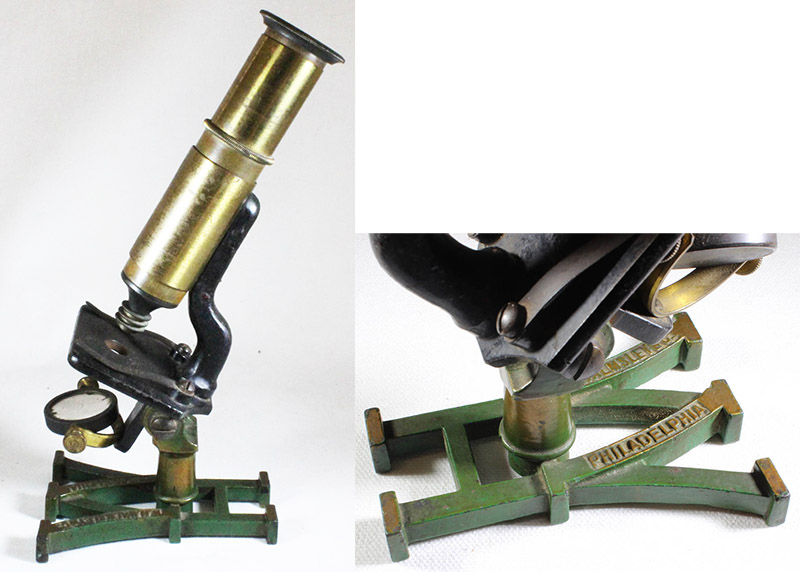
Figure 3.
An inexpensive “household” microscope from W.H. Walmsley. The foot is in the shape of Walmsley’s initials, and carries the raised words “W.H. Walmsley & Co.” and “Philadelphia”. That company was in business from 1884 until 1889. These inexpensive microscopes feature button objective lenses, and were anonymously made in France. Adapted with permission from http://www.microscope-antiques.com/walmsleyhh.html.
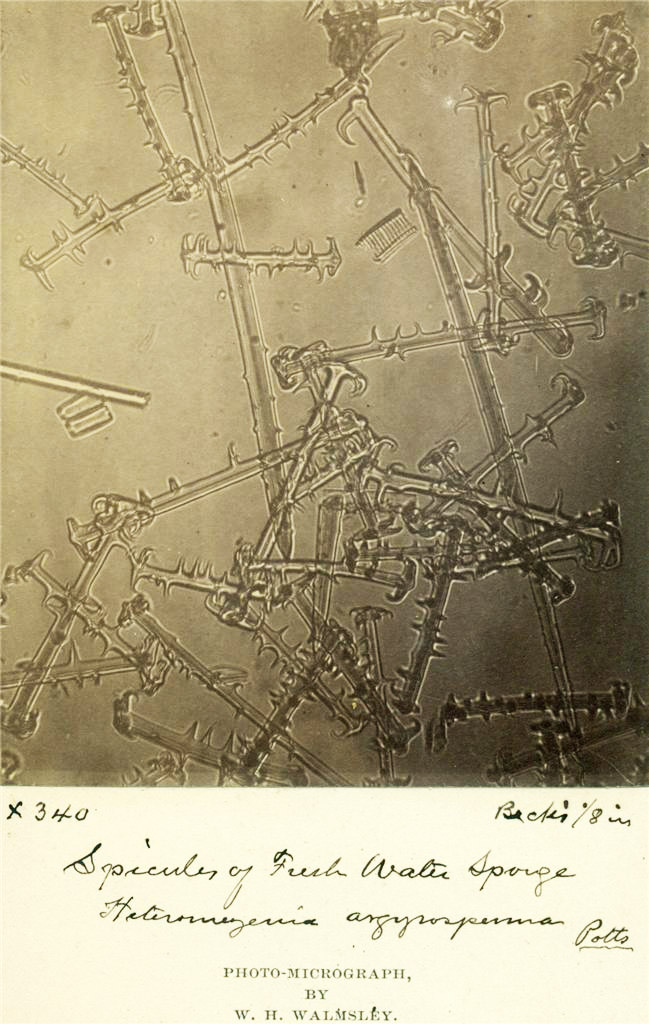
Figure 4.
A photomicrograph of sponge spicules, by W.H. Walmsley. He was a noted expert in photography of microscopic subjects.
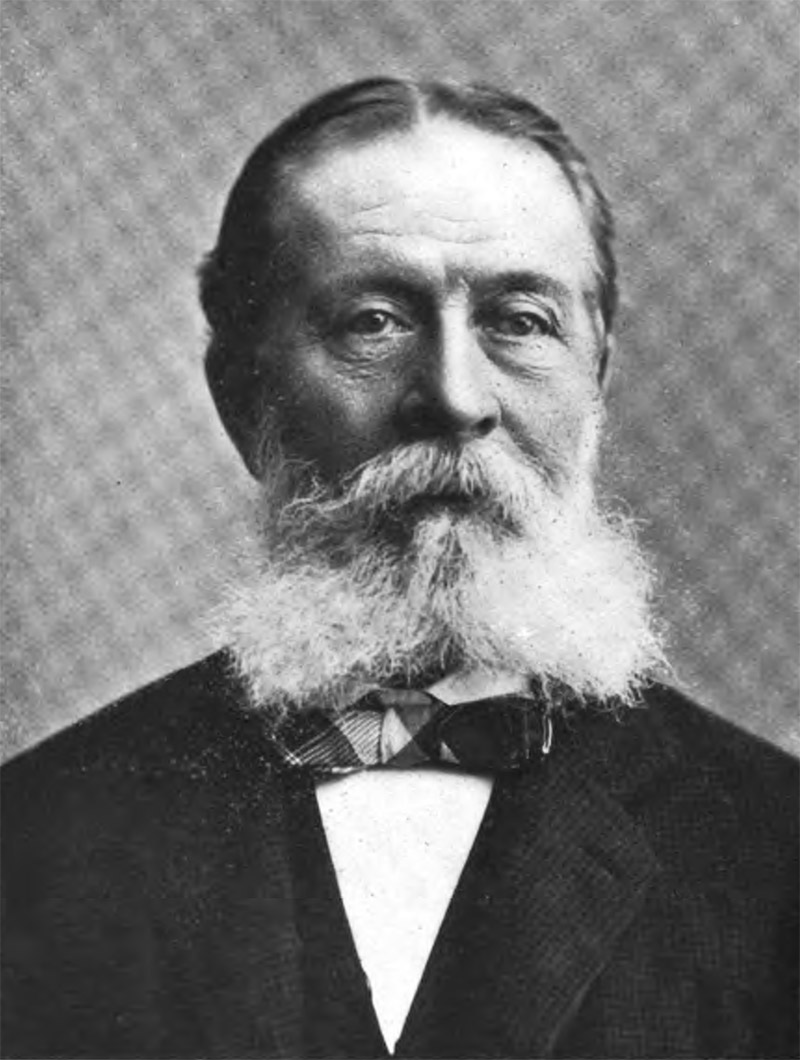
Figure 5.
William Henry Walmsley, ca. 1900. From his obituary that appeared in the “Transactions of the American Microscopical Society”.
The eldest of seven children, William Walmsley was born on October, 1830, in Byberry, Pennsylvania. The family situation was such that William was able to attend a boarding school. He was noted to have strong interests in botany and other sciences. Things changed in September, 1849, when William’s father, Thomas, died. William left school, and worked to support his mother and siblings at the “wholesale dry goods house of Barcroft and Beaver in Philadelphia”. The 1850 US census listed William as being a “clerk”.
Walmsley evidently did well enough in retail to marry, on November 23, 1854, to Annie M. Bunting. Because he was a member of the Society of Friends (“Quakers”), and she was Episcopalian, he was “read out of meeting” of his denomination. A daughter, Elizabeth, was born in 1855, followed by another daughter, Maude, in 1861. A third child, Georgianna, was born in 1863, but died within 5 months. Another daughter, Mabel, was born in 1865, who survived. She was followed by two boys, who both died in infancy.
In about 1864, Walmsley took work as a “retail dealer” in Providence, Rhode Island. The 1865 New England Business Directory and Gazetteer stated that he was the local sales agent for the Wheeler & Wilson Sewing Machine Company. The Walmsley’s second child, Mabel, was born in Providence on April 10, 1865.
A memorial written by Walmsley’s colleague J. Frederick Herbert stated that “in Providence, R.I., about 1865, he became interested in the study of the microscope and the preparation and mounting of slides”.
The Walmsley family moved back to Philadelphia in 1866. Son William was born in that city on May 23, 1866. He died less than a month later.
Walmsley worked in Philadelphia as agent for the Elliptical Sewing Machine Company. Their shop was located at 923 Chestnut Street. This was adjacent to the microscope and scientific instrument shop of James W. Queen (1815-1890), which was at 924 Chestnut Street. Presumably, this is where he met Queen.
Walmsley partnered in 1868 with an Alfred H. Keen to sell sewing machines. The Keen & Walmsley shop was located at 920 Arch Street.
William’s interests in the sciences led him to join the Academy of Natural Sciences of Philadelphia, on May 26, 1868. He was a regular attendee of meetings, and a frequent exhibitor and donor of microscope slides. Examples include “three preparations of the lung, liver and kidney of the rattlesnake injected” (December 6, 1869), “mounted sections of a testicle removed from a so-called hermaphrodite, who otherwise presented the external configuration of a woman, and who was looked upon in society as a female. The testicle exhibited tubular structure, and was removed at the patient's request” (February 7, 1870), and “some brilliant fresh-water algae, which had been mounted for a year in carbolic acid water, still retaining their color completely” (March 21, 1870).
Walmsley’s experience in selling precision machinery and knowledge of microscopy made him an ideal partner to take over J.W. Queen’s business when the latter retired in 1870. Queen publicly announced his retirement and the formation of the new company in a widely-published letter. He wrote “William H. Walmsley, well known throughout the country as a Microscopist, and also a preparer of Microscopic Specimens, will take the Department of Optics, which will comprise Spectacles, Microscopes, Microscopic Objects and Accessories, Opera Glasses, Spy Glasses, Telescopes, Ophthalmoseopes, &c., &c.”. Two other partners made up the company, Samuel L. Fox (1834-1912) and Jesse S. Cheyney (1837-1909). Fox had been an employee of Queen’s since the business started, in 1853, and the two had formed a partnership in 1858. According to Queen, Fox “will devote himself to the Mathematical Department, which will comprise Drawing Instruments, of every description, Surveying Compasses, Engineer’s Transits and Levels, Surveying Chains, Tape Measures, Drawing Papers, and materials of all kinds used by engineers and draughtsmen”. Cheney, “formerly Principal of Friends’ Select School, in this city, will take the Department of Philosophy, which will comprise Magic Lanterns, Oxy-Calcium and Dry-Hydrogen Stereoscopticons, with Pictures and Illustrations from all countries and upon all scientific subjects; Thermometers, Barometers, Globes, Air Pumps, Electric Machines, Magnetic Apparatus, &c., &c.”.
J.W. Queen and Company manufactured their own microscope and other instruments. In addition, they imported items that were then stamped with Queen’s name. The firm also served as agents for renowned microscope firms. Their 1874 catalogue features microscopes manufactured by R. & J. Beck, Henry Crouch, Joseph Zentmayer, Nachet, Edmund Hartnack, and lenses made by Ross and Powell & Lealand. They sold microscope slides by Edmund Wheeler, John Norman, Charles Topping, Johann Möller, the Bourgogne family, Constant Verick, William Walmsley, “and other foreign and American artists”.
Many of Walmsley’s slides indicate the prize that he won in September, 1870 at the Exhibition of the American Institute, in New York (see Figure 1). The announcement of that award stated that he represented James W. Queen and Co.
J.S. Cheyney had been managing the company’s branch in New York City. He left Queen in early 1876, and started his own optical and scientific instrument business in that city. By the end of 1877, he was back in Philadelphia, competing against J.W. Queen. Cheyney’s instruments are rarely seen nowadays, although microscope slides labeled “J.S. Cheyney” are occasionally encountered.
J.W. Queen & Co. exhibited at the 1876 Centennial Exposition in Philadelphia. They were “commended for the variety, accuracy, finish, workmanship, excellence, and cheapness of their instruments for the use of draughtsmen. The microscope stands presented by the exhibitors are convenient and elegant, well finished in every respect, and remarkably cheap. The objectives, forming a series from one and one-half to one-fifth inch, give extremely satisfactory results, and are well adapted to the uses of working microscopists. They are likewise furnished at extremely low prices”.
Walmsley also exhibited his microscope slides at the 1876 Exposition. His entries were described, “The objects, which belong mostly to natural history, are remarkable for perfection of parts and for clearness and neatness of mounting. The different tissues in the vegetable organisms are brought out by double staining with aniline colors and carmine. By mounting in glycerine jelly the natural colors of many are perfectly preserved”. Walmsley won a medal for his slides, which is mentioned on some of his later preparations (see Figure 1). Henry Crouch, the English microscope-maker, visited the Exposition, and later wrote, “Mr. Walmsley, of the firm of J.W. Queen & Co., Dr. Beattie, of Baltimore, and Mr. Edmund Wheeler, of London, were, I believe, the only exhibitors of prepared specimens for the microscope. The latter gentleman exhibited an excellent series, including some very fine transparent injections. Mr. Walmsley and Dr. Beattie both submitted some very excellent specimens of the double staining of vegetable tissues, a subject to which considerable attention has been devoted in the United States”.
in March, 1877, William Walmsley left J.W. Queen & Company. He published a letter in The American Journal of Microscopy and Popular Science, “Having withdrawn from the firm of James W. Queen & Co., of which I have been a member during the past seven years, I would hereby give notice to my personal friends, and to microscopists generally throughout the country (to most of whom I am known, by reputation at least,) that I shall shortly open in American Branch of the London House of R. & J. Beck: and shall be prepared with a large and varied stock in every department of the Science to meet the wants of all. Due notice will be given of the opening, which will take place immediately upon my return from Europe, where I go to make personal selection of goods. Meanwhile, communications addressed to my residence, No. 2320 DeLancey Place, Philadelphia, Pa., will meet prompt attention”.
A follow-up announcement was published in several journals: “from R. & J Beck, Microscopical Instrument Makers, London, June 12th, 1877 - Dear Sir: The demand for our Optical and other Scientific instruments in America, during the past six years, has been so satisfactory and so steadily increasing, that we have determined to open a branch house in Philadelphia, in order more fully to meet the advancing demand, under the management of Mr. W.H. Walmsley, who has hitherto conducted our agency as a member of the firm of James W. Queen & Co. Office of R. & J. Beck, 921 Chestnut St., Philadelphia”. The new Beck shop was almost next-door to their former distributor Queen, who was at 924 Chestnut. There was probably a sound business strategy to this location, calculating that customers who went to the Queen shop to purchase a Beck instrument would walk a few steps to the Beck shop, rather than settle for a different brand that Queen had in stock.
The following year, Walmsley played a key role in another major aspect of American microscopy. On August 14, 1878, the first National Microscopical Congress was held in Indianapolis, Indiana. This had been organized by some enthusiastic volunteers, who mailed invitations to American microscopical societies and prominent microscopists. Walmsley attended, as did microscope-makers Edward Bausch and Walter Bulloch, American Monthly Microscopical Journal editor/publisher Romyn Hitchcock, and a few dozen other people. The major outcome of the Congress was establishment of the American Society of Microscopists (now the American Microscopical Society).
During 1879, the R. & J. Beck shop moved up the road a short distance, to 1016 Chestnut Street (Figure 11).
Beck and Walmsley rearranged their business in 1884. Walmsley now operated his own, separate company, who served as sole U.S. agents for Beck. Walmsley was also permitted to distribute the works of other manufacturers. This was explained in The American Monthly Microscopical Journal, “Mr. W.H. Walmsley, for six years the business manager for Messrs. R. & J. Beck, in Philadelphia, has issued a circular, dated January 1st, in which he informs the public that the American branch of the Messrs. Beck's business has been purchased by the new firm of W.H. Walmsley & Co., and will hereafter be conducted by the new firm at the same place as heretofore. Messrs. W.H. Walmsley & Co. possess the sole and exclusive agency for all the manufactures of Messrs. R. & J. Beck in the United States, but orders for instruments of all makers will hereafter receive prompt attention. Mr. Walmsley promises his personal attention to all orders, as heretofore; and, having ample capital invested, he asks for the new firm a continuance of the liberal patronage hitherto enjoyed by himself. The members of the new firm are W.H. Walmsley, Isaac Collins, and Morris Earle. The address of the new firm can always be found in our advertising pages”.
That same year, on March 12, William Walmsley was elected as a Fellow of the Royal Microscopical Society.
The distributorship deal with Beck was an evident success. On November 8, 1887, Walmsley visited a meeting of the Washington, D.C. Microscopical Society, which was reported as, “A pleasant feature of the evening was the presence of Mr. Walmsley, of Philadelphia, who showed and explained a 'Star' microscope of Messrs. Beck & Co. The serial number on this microscope was above 15,000, and in the course of his remarks Mr. Walmsley stated that he alone had sold over 5,000 Beck instruments in the United States since his first connection with that firm”. The minutes further noted that, “The same gentleman also exhibited a number of fine photo-micrographs”. Photography, and photographing microscopical objects, had become a major interest of Walmsley’s.
At the beginning of April, 1889, W.H. Walmsley and Company was dissolved. A series of announcements described the changes: the old premises and stock were taken over by a new firm that was led by former partner Morris Earle, and a second firm, W.H. Walmsley, Ltd., would operate from another location. From Anthony’s Photographic Bulletin, “The firm of W.H. Walmsley & Co. having been dissolved by mutual agreement, Mr. W.H. Walmsley, the founder and senior member thereof, has, in conjunction with others, formed a limited corporation, under the title of W.H. Walmsley, Limited. The photographic department will be under the management of Mr. J. Milnor Walmsley, who for the past five years has been at the head of that branch in the house of W.H. Walmsley & Co. The new corporation have secured commodious quarters at 1022 Walnut street, Philadelphia, where they hope to see all old and many new friends.” and “Morris Earle & Co. write us that we were mistaken about the change in their business. Walmsley & Company no longer exists; they are conducting the business at 1016 Chestnut street, Philadelphia, and are the agents for Beck's Lenses. Mr. W. H. Walmsley is now doing business at 1022 Walnut street, Philadelphia, under the firm name of W. H. Walmsley. Limited, where he has an entirely new stock of photographic and optical apparatus”. The May issue of Anthony’s Photographic Bulletin featured advertisements from the two competing businesses (Figure 16). The Chestnut Street and Walnut Street shops were only about two blocks apart, close enough to compete fiercely.
The manager of W.H. Walmsley, Ltd., J. Milnor Walmsley, was William’s nephew. As their announcement stated, he had run the photography department of W.H. Walmsley & Co. for several years, and was undoubtedly qualified to do so with the new business.
W.H. Walmsley, Ltd. made a serious attempt to succeed in the photographic supply business. A catalogue was promptly issued, and, in 1891, a second edition was produced: “The second edition of the illustrated catalogue of cameras, lenses, and other apparatus and materials for photography and photo-micrography made, imported, and sold by W.H. Walmsley, Limited, has come to our table, and is a well printed and conveniently arranged catalogue. It is very complete, listing only the best goods; and should be in the hands of every photographer, especially those interested in photo-micrography. A class list of photo-micrographs and lantern slides from negatives by W.H. Walmsley, comes with the catalogue”.
Nonetheless, the business ended around 1894. This was probably aided by the “Panic of 1893” and associated economic depression.
Possibly because he saw that the business was faltering, William Walmsley set off in another direction.
The Photo-Beacon announced in August, 1892, “Coming West - Our esteemed friend, Mr. W.H. Walmsley, of Philadelphia, so long and favorably known in connection with the microscope and photographic apparatus, material and appliances, has caught the western fever and left the delightful but slow-going Quaker City, and taken up his abode in our go-ahead Chicago, where his knowledge and experience will be thoroughly appreciated by what will be in the near future the most advanced scientific and art community in the country. Mr. Walmsley will be found in the establishment of the Geneva Optical Company, at 67 and 69 Washington street, presiding over the microscopic and photographic departments, where he will be glad to meet all who are interested in either of those branches of science”.
Anthony's Photographic Bulletin reported in 1893, “Mr. W.H. Walmsley, of the Geneva Optical Company, of Chicago, has sent us one of their illustrated catalogues, the receipt of which we would here acknowledge. Some of the photo-micrographic cameras depicted therein are after Mr. Walmsley's own designs, and the construction and finish is excellent”.
Employment by Geneva Optical lasted about two years. The December, 1894 issue of The School Board Journal reported, “The new firm of Walmsley, Fuller & Co., physical and chemical apparatus and supplies, has been formed at Chicago with salesrooms and laboratories at 132-36 Wabash Ave. W. H. Walmsley, the senior member, was for some years connected with Queen & Co., of Philadelphia. He is well known by the educational public throughout the United States. Mr. Fuller has had charge of the Science department of the Alfred L. Robbins Co. The firm will have an exceptional equipment in every particular and starts out under the most favorable auspices. The equipment and stock will be large and complete and competent men placed at the head of its various departments”. The February, 1895 issue of The Observer wrote, “Mr. W.H. Walmsley, so well and so favorably known to our readers as a dealer in microscopical and photographic goods, has formed a partnership with Mr. H.F. Fuller, under the firm name of Walmsley, Fuller & Co., at 134-136 Wabash Avenue, Chicago. The new firm will deal largely in microscopical goods, including the Eclipse microscope, made by Ross Co. at Mr. Walmsley's suggestion, optical lanterns and slides, photographic goods, etc., etc. Catalogues may be had for the asking, and we bespeak for the new firm a generous share of patronage.” That business seems to have lasted for a couple of years.
Another firm, Walmsley & Company, appears in records during 1897, with several patents in acetylene gas apparatus. Certainly not a coincidence, Walmsley published a paper in 1897, entitled, “Acetylene gas as the illuminant in photomicrography”. This operation lasted only a year or so.
The 1899 Transactions of the American Microscopical Society listed Walmsley’s address as 4248 Pine St., Philadelphia, Pennsylvania. The 69 year-old was home for good. Although he may have had some financial interests, Walmsley does not appear to have been an active participant in any further businesses.
He published widely-endorsed a book, The ABC of Photo-micrography: A Practical Handbook for Beginners, in 1902
“Mr. W.H. Walmsley, the well-known optician, died suddenly at his home in Philadelphia, Sunday evening, October 22 (1905), in his seventy-fifth year. For nearly forty years Mr. Walmsley was engaged in the optical line, and recognized as an authority in microscopical and photographic work”.
Time line of William Walmsley’s businesses
1864 - 1866: Sewing machine sales, Providence, Rhode Island
1866 - 1870: Sewing machine sales, Philadelphia, Pennsylvania
1870 - 1877: J.W. Queen and Company, co-owner, Philadelphia, Pennsylvania
1877 - 1884: R. and J. Beck, manager, Philadelphia, Pennsylvania
1884 - 1889: W.H. Walmsley and Company, co-owner, Philadelphia, Pennsylvania
1889 - ca. 1894: W.H. Walmsley, Limited., owner, Philadelphia, Pennsylvania
1892 - 1894: Geneva Optical Company, manager, Chicago, Illinois
1894 - ca. 1896: Walmsley, Fuller and Company, co-owner, Chicago, Illinois
ca. 1896 - ca. 1898: Walmsley and Company, co-owner, Chicago, Illinois
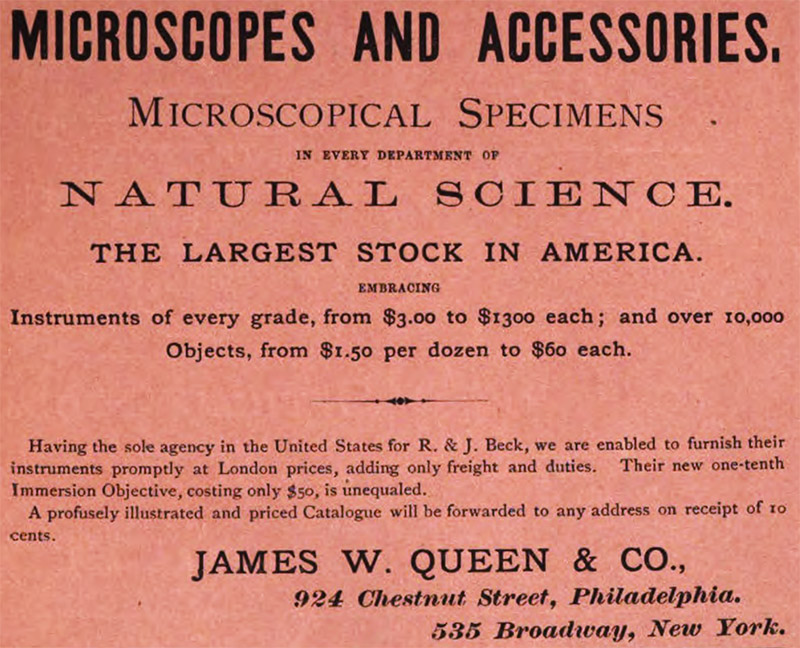
Figure 6.
Advertisement from “The Lens”, 1872.
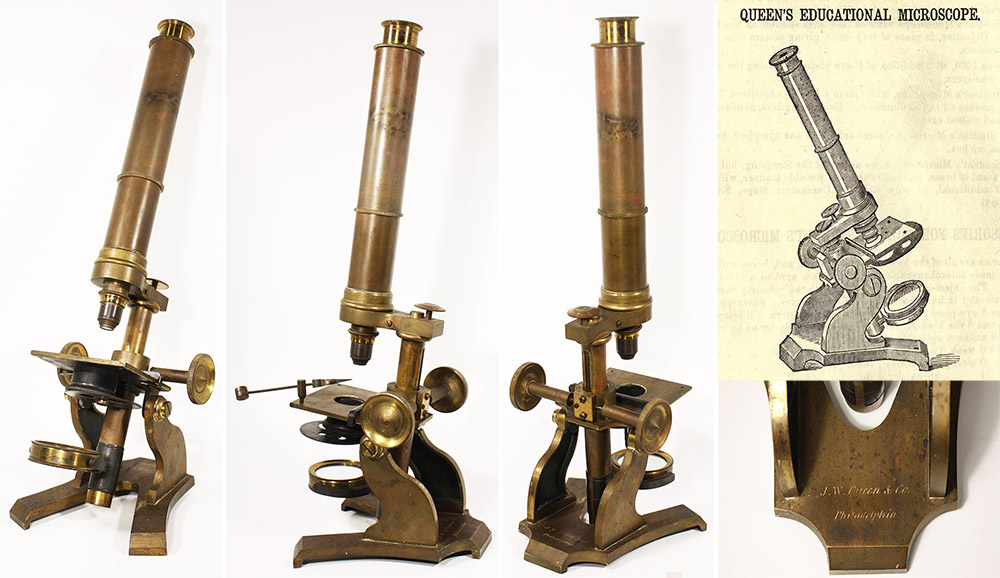
Figure 7.
J.W. Queen & Co.’s “Educational” microscope, and an excerpt from their 1872 catalogue.

Figure 8.
J.W. Queen & Co.’s “Student” microscope, and an excerpt from their 1872 catalogue. Adapted with permission from http://www.antique-microscopes.com/photos/Queen_studentl_microscope.htm.
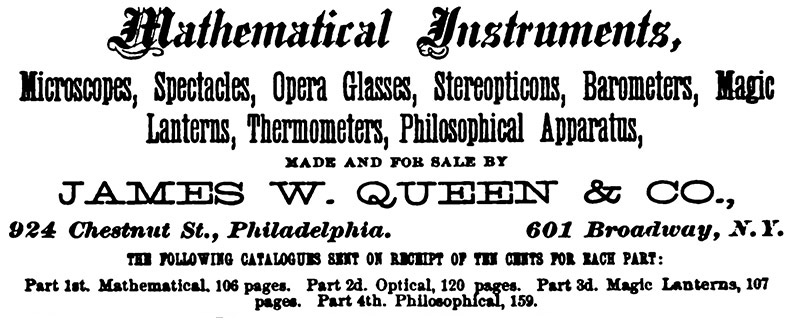
Figure 9.
An 1876 advertisement from “Burley's United States Centennial Gazetteer and Guide”,.
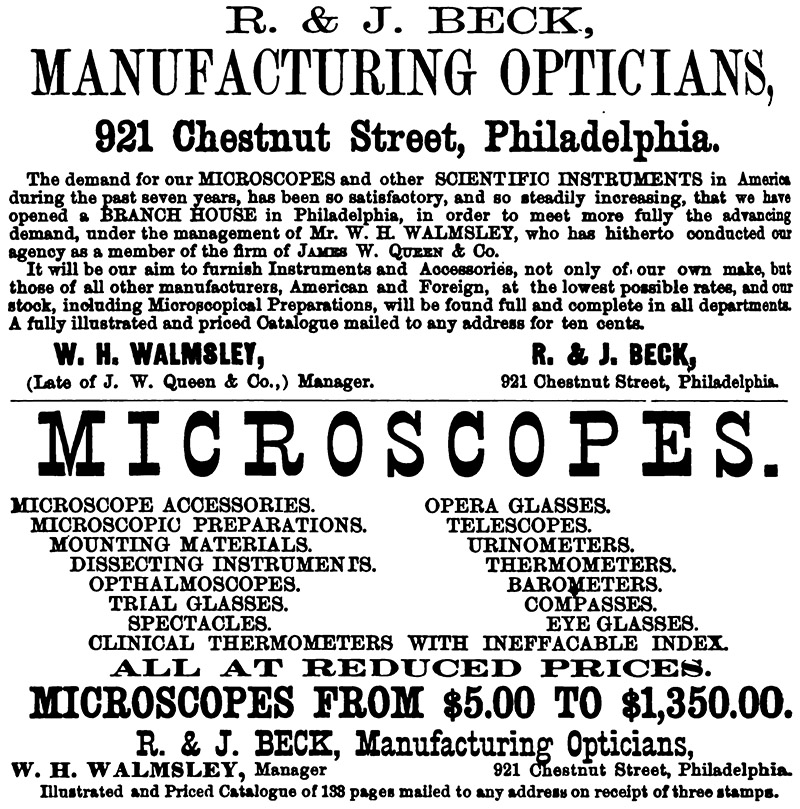
Figure 10.
Two advertisements from “The American Journal of Microscopy and Popular Science”, 1878
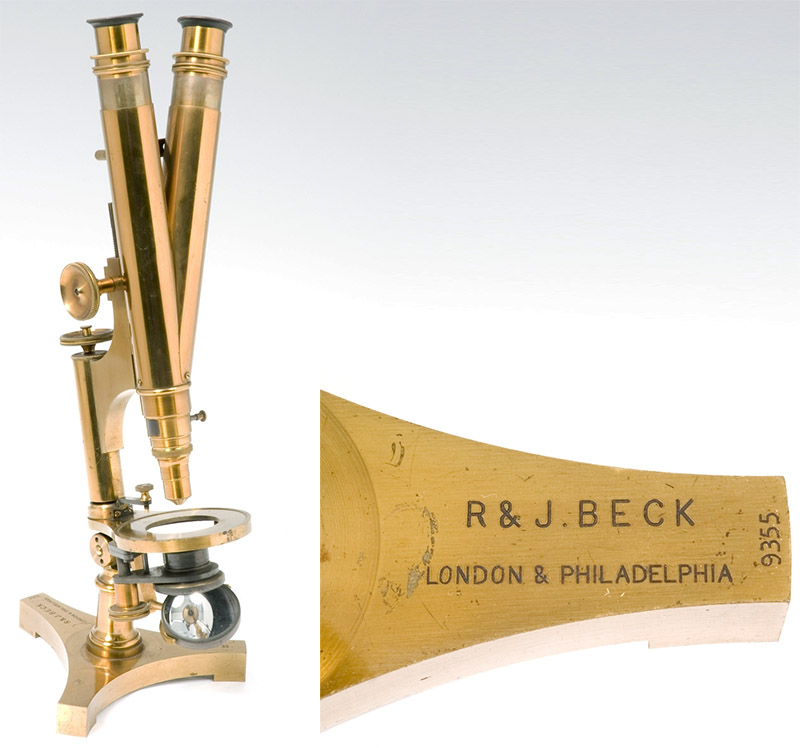
Figure 11.
An R. & J. Beck “Economic” microscope, retailed in USA by R. & J. Beck (W.H. Walmsley, manager). Adapted for nonprofit, educational purposes from http://www.mhs.ox.ac.uk.
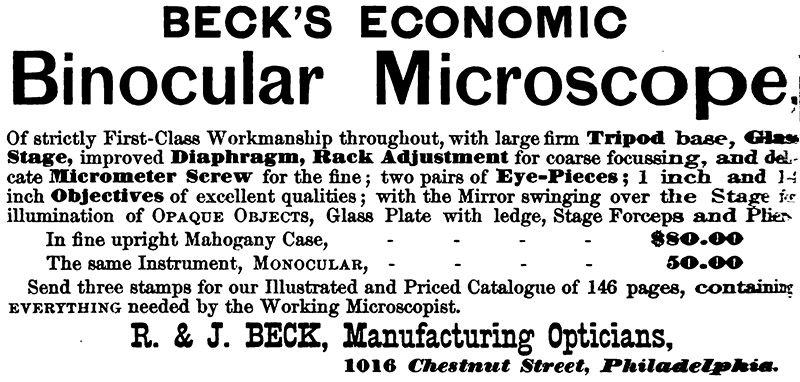
Figure 12.
1879 advertisement from “The American Journal of Microscopy and Popular Science”. The business moved to 1016 Chestnut Street in 1879.
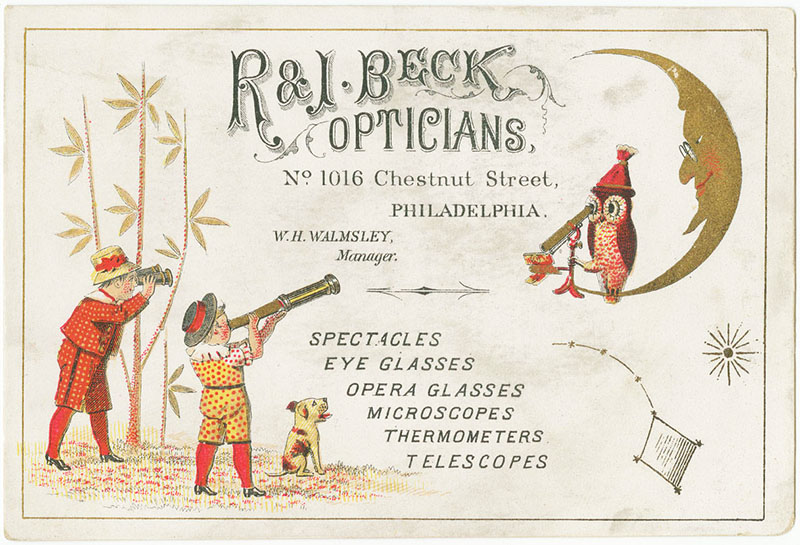
Figure 13.
Trade card from R. & J. Beck, 1016 Chestnut Street, Philadelphia. They were at this address from 1879 until the branch was acquired by W.H. Walmsley & Co. in 1884.
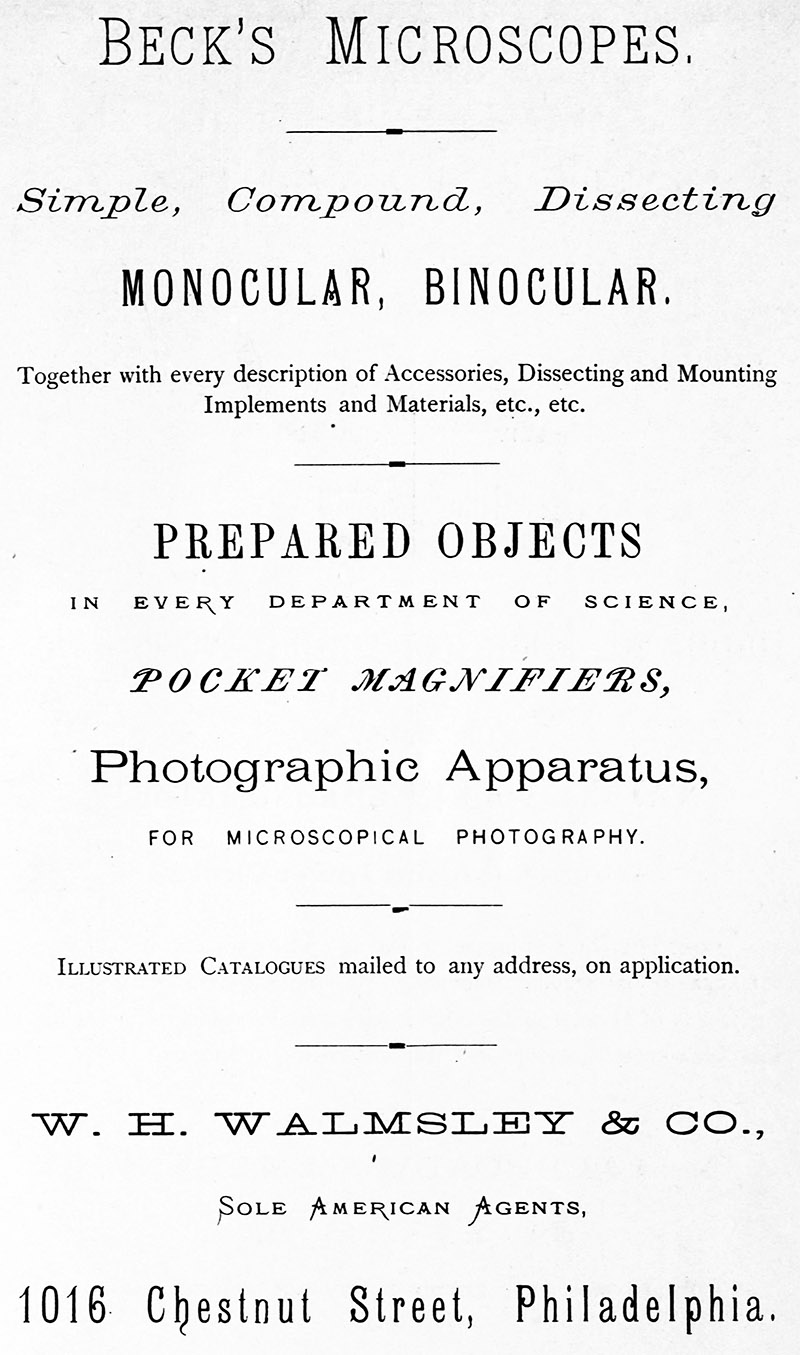
Figure 14.
1885 advertisement from “The Microscope in Botany”.
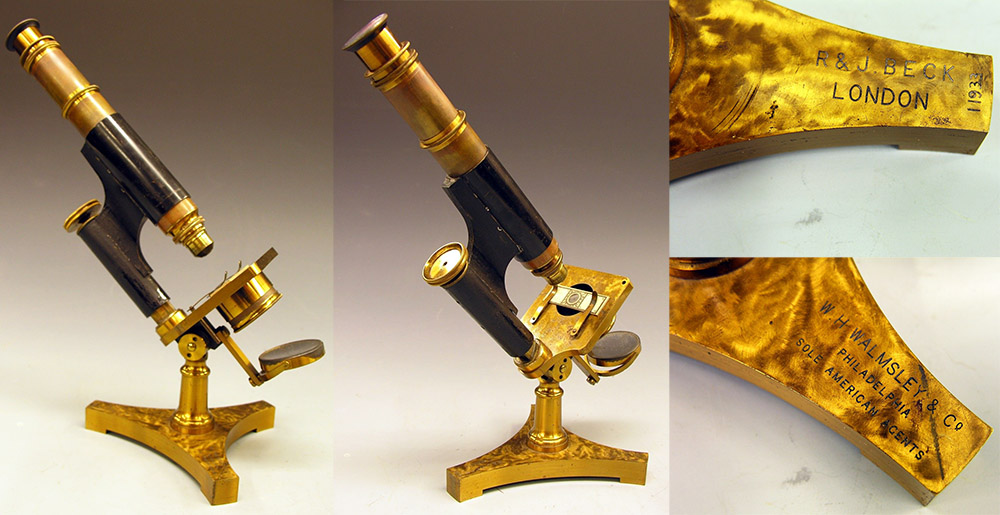
Figure 15.
R. & J. Beck microscope 11933, retailed by W.H. Walmsley & Co.
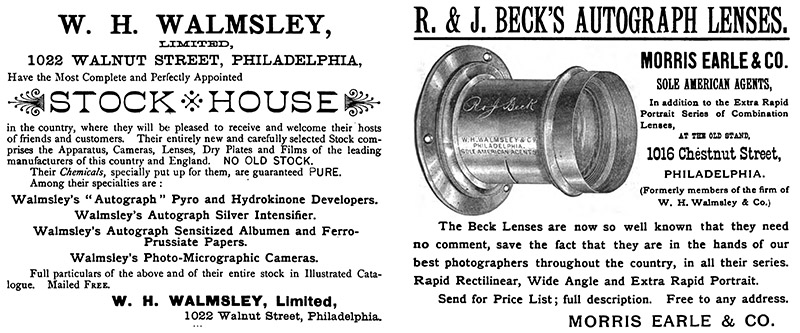
Figure 16.
Two May, 1889 advertisements from “Anthony's Photographic Bulletin”. W.H. Walmsley & Co. had been acquired by Morris Earle & Co., and Walmsley started a new business, W.H. Walmsley, Ltd.
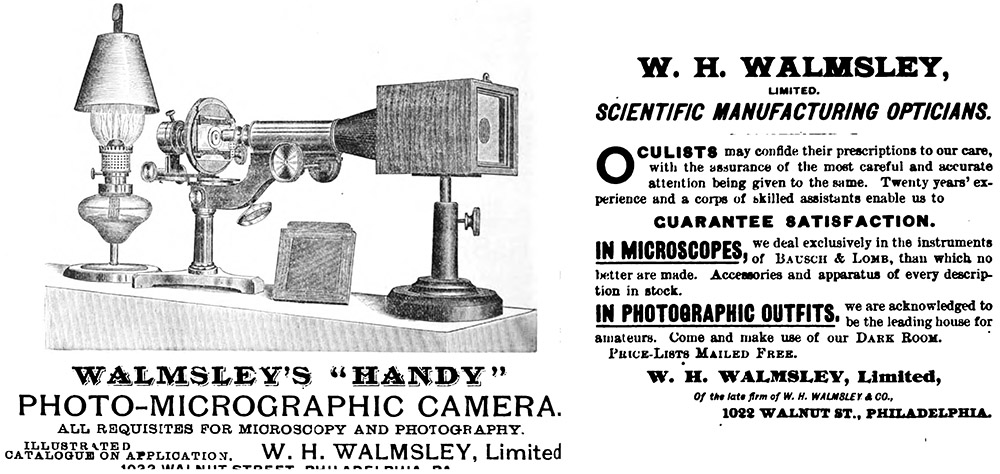
Figure 17.
Two 1890 advertisements from “The Microscope” (left) and “The Medical Bulletin” (right).
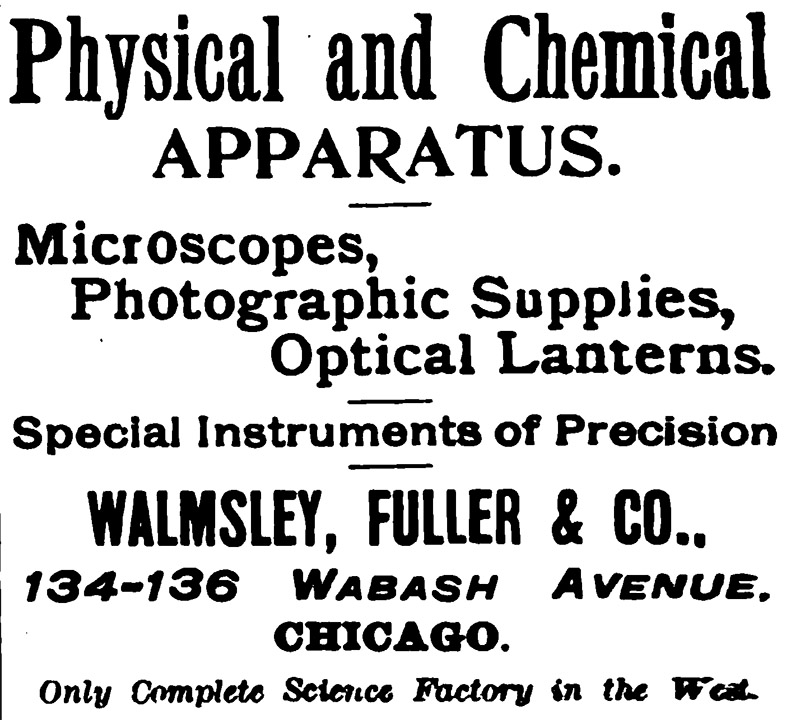
Figure 18.
December, 1894 advertisement from “The School Journal”.
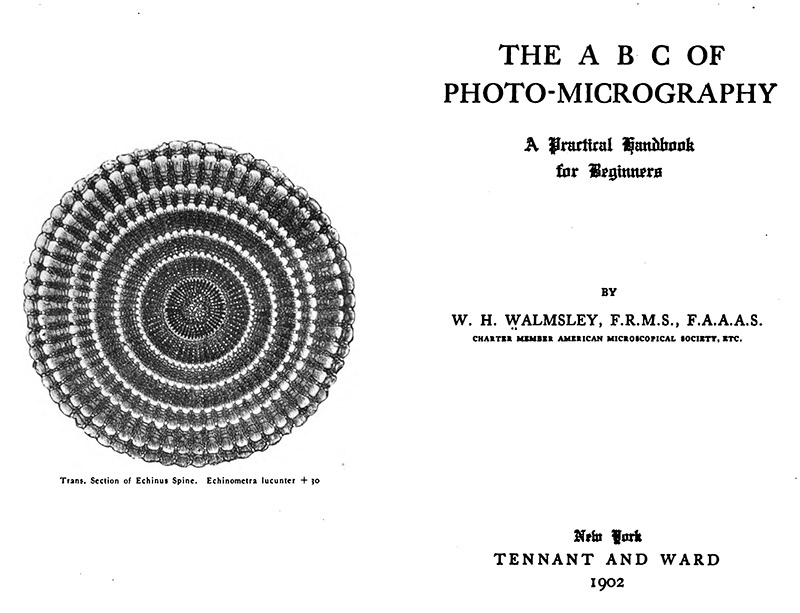
Figure 19.
Frontispiece and title page from William Walmsley’s 1902 “The ABC of Photo-Microscopy: A Practical Handbook for Beginners”.
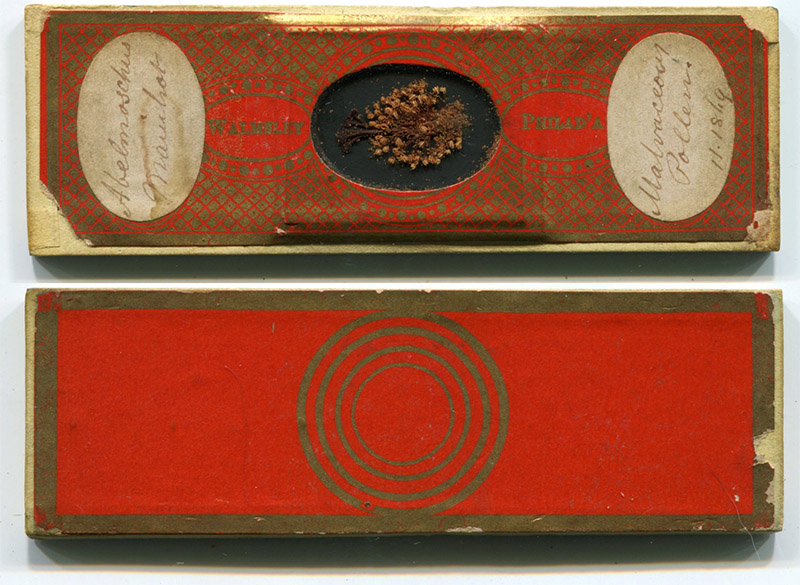
Figure 20.
Front and back views of a William H. Walmsley microscope slide, dated November, 1869.
Resources
The American Journal of Microscopy and Popular Science (1878) Advertisements from R. & J. Beck, Vol. 3, April and November issues
The American Journal of Microscopy and Popular Science (1879) Advertisements from R. & J. Beck, Vol. 4, September issue
American Microscopical Society web site (accessed January, 2018) http://amicros.org
American Monthly Microscopical Journal (1884) Important business change, Vol. 5, page 13
American Monthly Microscopical Journal (1887) Microscopical societies, Vol. 9, page 18
American Monthly Microscopical Journal (1893) Advertisement from W.H. Walmsley, Ltd., Vol. 14, February issue
The American Naturalist (1876) “James W. Queen & Co. - This well-known firm has been once more dissolved, Mr. Cheyney carrying the department of philosophical apparatus with him to Bond Street, New York city. The remaining partners, S.L. Fox and W.H. Walmsley, retain the microscopical branch of the business at the old stand and under the old name. Microscopists will find G.S. Woolman in charge of their department at the New York store”, Vol. 10, page 123
The American Stationer (1890) James W. Queen, Vol. 28, page 125
Annual Report of the American Institute of the City of New York for 1870-71 (1871) “Premiums awarded at the thirty-ninth annual Exhibition, 1870 ... William H. Walmsley, 924 Chestnut street, Philadelphia; James W. Queen & Co., agents, 5 Dey street, New York; for the best microscopic preparations. First premium”, pages 19-22
Anthony's Photographic Bulletin (1889) Vol. 20, pages 192 and 384
Anthony's Photographic Bulletin (1889) Advertisements, Vol. 20, February 23 and May 25 issues
Anthony's Photographic Bulletin (1893) “Mr. W.H. Walmsley, of the Geneva Optical Company, of Chicago, has sent us one of their illustrated catalogues, the receipt of which we would here acknowledge. Some of the photo-micrographic cameras depicted therein are after Mr. Walmsley's own designs, and the construction and finish is excellent”, Vol. 24, page 127
Behrens, Julius W. (1885) The Microscope in Botany, A.B. Hervey (translator), S.E. Cassino and Co., Boston, advertisement in back of the book
Bracegirdle, Brian (1998) Microscopical Mounts and Mounters, Quekett Microscopical Club, London, pages 78, 97, and 178, and plate 37-E
Burley's United States Centennial Gazetteer and Guide (1876) advertisements on pages 818 and 830
Crouch Henry (1877) On microscopy in the United States, The American Journal of Microscopy and Popular Science, Vol. 2, pages 53-56
Fletcher, Randol B. (2011) Hidden History of Civil War Oregon, The History Press, Charleston, South Carolina
Herbert, J. Frederick (1912) William Henry Walmsley, Transactions of the American Microscopical Society, Vol. 31, pages 219-220
International Exhibition Official Catalogue (1876) “Walmsley, W.H. Philadelphia, Pa. - Microscopic Preparations”, page 331
International Exhibition Reports and Awards (1876) pages 174 and 188
James W. Queen & Company Optical Catalogue (1872) bound within The Lens, Vol. 4
James W. Queen & Company Optical Catalogue (1874) 84th Edition
Journal of the Royal Microscopical Society (1884) Minutes of the meeting of March 12, Vol. 4, page 336
The Lens (1872) Letter from James W. Queen, accompanying enclosed catalogue
The Medical Bulletin (1890) Advertisements from W.H. Walmsley, Ltd, Vol. 12, page 38
The Microscope (1890) Advertisements from W.H. Walmsley, Ltd, Vol. 10, numerous issues
Missouri Dental Journal (1877) The following speaks for itself, Vol. 9, page 283
The National Cyclopaedia of American Biography (1918) Fuller, Henry Frederick, Vol. 16, pages 287-288
The Naturalists’ Directory (1878) page 114
The Naturalists’ Directory (1879) page 191
The Naturalists’ Directory (1894) page 236
The New England Business Directory and Gazetteer (1865) “Sewing Machines … Wheeler & Wilson Sewing Machine Co., W.H. Walmsley, agent, Howard building, 139 Westminster, and 13 Dorrance”, page 638
The Observer (1892) “The many friends of Mr. W. H. Walmsley, one of Philadelphia's long-time leading opticians, will be glad to learn that he is now located at Chicago. Mr. Walmsley is with the Geneva Optical Co. at 67 and 69 Washington street, having entire charge of two departments of the business, microscopes and photographic lenses and outfits”, Vol. 3, page 257
The Observer (1895) “Mr. W.H. Walmsley, so well and so favorably known to our readers as a dealer in microscopical and photographic goods, has formed a partnership with Mr. H.F. Fuller, under the firm name of Walmsley, Fuller & Co., at 134-136 Wabash Avenue, Chicago. The new firm will deal largely in microscopical goods, including the Eclipse microscope, made by Ross Co. at Mr. Walmsley's suggestion, optical lanterns and slides, photographic goods, etc., etc. Catalogues may be had for the asking, and we bespeak for the new firm a generous share of patronage”, Vol. 6, page 30
Padgitt, Donald L. (1975) Jesse S. Cheyney, in A Short History of Early American Microscopes, Microscope Publications Ltd., London and Chicago, page 114
Philadelphia City Directory (1867) “Walmsley William H., agent for the Elliptical Sewing Machine Co., 923 Chestnut, h 509 S 15th”, page 1289
Philadelphia City Directory (1868) “Walmsley William H. (Keen & Walmsley), h Beverly, NJ”, page 1582
Philadelphia City Directory (1868) “Keen & Walmsley (Alfred H. Keen & William H. Walmsley), sewing machines, 920 Arch”, page 873
Philadelphia City Directory (1874) “Walmsley William H. (James W. Queen & Co.), h 141 N 21st”, page 1348
Philadelphia City Directory (1889) pages 1836-1837
Philadelphia City Directory (1891) page 1925
The Photo-Beacon (1892) Coming west, Vol. 4, page 246
The Photo-Beacon (1905) W.H. Walmsley, Vol. 17, page 384
Photographic Times and American Photographer (1884) Changes of firm, Vol. 14, page 47
Photographic Times and American Photographer (1891) Note on catalogue from W.H. Walmsley, Ltd., Vol. 21, page 58
Photographic Times and American Photographer (1892) “Mr. W.H. Walmsley, W.H. Walmsley (Ltd.), of Philadelphia, has recently connected himself with the Geneva Optical Co. of Chicago, where he will have charge of the photographic department. It is needless to say that the department will be well managed with Mr. Walmsley at its head”, Vol. 22, page 443
Proceedings of the Academy of Natural Sciences of Philadelphia (1868) “May 26 .. The following gentlemen were elected members : Mr. Edward Lewis, Jas. Truman, M.D., Wm. Trueman, M.D., Mr. S. Fisher Corlies, Mr. T.W. Starr, Edw. Rhoads, M.D., T. H. Andrews, M.D., Herbert Norris, M.D., Mr. Jas. S. Gilliams, Mr. Charles Bullock, Mr. Edw. L. Huitt, Mr. J. Zentmayer, Mr. Aug. F. Muller, F.F. Maury, M.D., Horace Williams, M.D., Mr. Wm. H. Walmsley, Mr. T. L. Buckingham”, page 148
Proceedings of the Academy of Natural Sciences of Philadelphia (1869) Minutes of the December 6 meeting, page 19
Proceedings of the Academy of Natural Sciences of Philadelphia (1870) Minutes of the February 7 and March 21 meeting
Proceedings of the American Gas Light Association (1898) Patent application for acetylene gas apparatus filed for Walmsley and Company, Vol. 16, page xc
Proceedings of the National Microscopical Congress (1878)
Providence, Rhode Island City Directory (1866) “Walmsley William H merchant, 139 Westminster, house 83 Smith”, page 168
The Queen Catalogues (1887) Norman Publishing, Philadelphia
Report of the Speeches at the Testimonial Entertainment Given by the Stockholders and Late Creditors of Queen & Co. to John Gordon Gray, together with a Short History of the Business of Queen & Co., 1010 Chestnut Street, Philadelphia (1896) Queen & Co., Philadelphia
The School Board Journal (1894) The new firm of Walmsley, Fuller & Co., Vol. 6, page 12
The School Journal (1894) “Colleges and schools of science who wish to fit up their laboratories should examine the catalogue of Walmsley, Fuller & Co., 134-136 Wabash avenue, Chicago. This firm has the only complete science factory in the West. Among the articles supplied are physical and chemical apparatus, microscopes, photographic supplies, optical lanterns, instruments of precision, etc.”, Vol. 49, page 594
The School Journal (1894) Advertisements from Walmsley, Fuller & Co., Vol. 49, December 15, 22, and 29 issues
The School Journal (1896) Queen & Co. reorganized, Vol. 52, page 530
United States census and other records (2018), accessed through ancestry.com
Walmsley, W.H. (1896) Some new points in photo-micrography and photo-micrographic cameras, Transactions of the American Microscopical Society, Vol. 17, pages 340-349
Walmsley, W.H. (1897) Acetylene gas as the illuminant in photomicrography, Transactions of the American Microscopical Society, Vol. 18, pages 136-141
Walmsley, W.H. (1899) Photo-microscopy with opaque objects, Transactions of the American Microscopical Society, Vol. 20, pages 189-193
Walmsley, W.H. (1902) The ABC of Photo-micrography: A Practical Handbook for Beginners, Tennant and Ward, New York
Wilson, Wendell E. (2017) Jesse S. Cheyney, Mineralogical Record, http://www.minrec.org/labels.asp?colid=1073



















